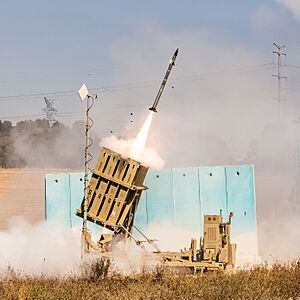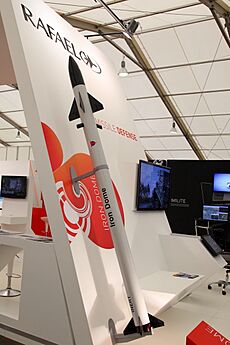Iron Dome facts for kids
Quick facts for kids Iron Dome |
|
|---|---|

Iron Dome launches interceptor, 2021
|
|
| Type | C-RAM and short range air defence system |
| Place of origin | Israel |
| Service history | |
| In service | 2011–present |
| Used by | Israel Defense Forces |
| Wars |
|
| Production history | |
| Designer |
|
| Designed | 2005 |
| Manufacturer |
|
| Unit cost | $50 million per battery $100,000–150,000 per interception |
| Produced | 2011–present |
| No. built | 10 batteries deployed (planned deployment is 15) |
| Specifications | |
| Mass | 90 kg (200 lb) |
| Length | 3 m (9 ft 10 in) |
| Diameter | 160 mm (6.3 in) |
|
Detonation
mechanism |
Proximity fuze |
|
|
|
| Maximum speed | Mach 2.2 |
|
Launch
platform |
Three/four launchers, each carrying 20 interceptors. |
Iron Dome (Hebrew: כִּפַּת בַּרְזֶל, romanized: Kippat Barzel) is an Israeli mobile all-weather air defense system, developed by Rafael Advanced Defense Systems and Israel Aerospace Industries. The system is designed to intercept and destroy short-range rockets and artillery shells fired from distances of 4 to 70 kilometres (2–43 mi) away and whose trajectory would take them to an Israeli populated area. From 2011 to 2021, the United States contributed a total of US$1.6 billion to the Iron Dome defense system, with another US$1 billion approved by the US Congress in 2022.
Iron Dome was declared operational and initially deployed on 27 March 2011 near Beersheba. On 7 April 2011, the system successfully intercepted a rocket launched from Gaza for the first time. On 10 March 2012, The Jerusalem Post reported that the system shot down 90% of rockets launched from Gaza that would have landed in populated areas. In late 2012, Israel said that it hoped to increase the range of Iron Dome's interceptions, from a maximum of 70 to 250 kilometres (43–155 mi) and make it more versatile so that it could intercept rockets coming from two directions simultaneously.
In November 2012, official statements indicated that it had intercepted over 400 rockets. By late October 2014, the Iron Dome systems had intercepted over 1,200 rockets. In addition to their land-based deployment, it was reported in 2017 that Iron Dome batteries would in future be deployed at sea on Sa'ar 6-class corvettes, to protect off-shore gas platforms in conjunction with Israel's Barak 8 missile system.
Name
Project leader Colonel S. and his team in the Administration for the Development of Weapons and Technological Infrastructure (Maf'at) needed an appropriate name for the system. According to Colonel S.,
The first name I thought of was 'Anti-Qassam', but when the project started to move forward I realized it was problematic... I sat down with my wife, and together we thought of suitable names. She suggested the name 'Tamir' (Hebrew acronym for טיל מיירט, Til Meyaret, 'interceptor missile') for the missile, and for the system itself we thought of 'Golden Dome'. The following Sunday, 'Tamir' was immediately approved, but there was a problem with 'Golden Dome'—it could be perceived as ostentatious. So it was changed to 'Iron Dome'.
Specifications
The system is designed to counter short-range rockets and 155 mm artillery shells with a range of up to 70 kilometers (43 mi). According to its manufacturer, Iron Dome will operate day and night, under adverse weather conditions, and can respond to multiple threats simultaneously.
Iron Dome has three central components:
- Detection & Tracking Radar: the radar system is built by Elta, an Israeli defense company and subsidiary of Israel Aerospace Industries, and by the IDF.
- Battle Management & Weapon Control (BMC): the control center is built for Rafael by mPrest Systems, an Israeli software company.
- Missile Firing Unit: the unit launches the Tamir interceptor missile, equipped with electro-optic sensors and several steering fins for high maneuverability. The missile is built by Rafael. A typical Iron Dome battery has 3–4 launchers (20 missiles per launcher).
The system's radar is referred to as EL/M-2084. It detects the rocket's launch and tracks its trajectory. The BMC calculates the impact point according to the reported data, and uses this information to determine whether the target constitutes a threat to a designated area. Only when that threat is determined, an interceptor missile is fired to destroy the incoming rocket before it reaches the predicted impact area.
Comparison to a typical battery
The typical air defense missile battery consists of a radar unit, missile control unit, and several launchers, all located at the same site.
Conversely, Iron Dome is built to deploy in a scattered pattern. Each launcher, containing 20 interceptors, is independently deployed and operated remotely via a secure wireless connection. Reportedly, each Iron Dome battery is capable of protecting an urban area of approximately 150 square kilometres (58 sq mi).
Images for kids
-
Iron Dome intercepting two rockets over Tel Aviv during Operation Protective Edge, 2014
See also
 In Spanish: Cúpula de Hierro para niños
In Spanish: Cúpula de Hierro para niños
- Iron Spade
- Multi-Mission Launcher











